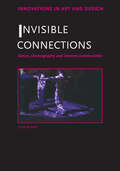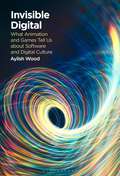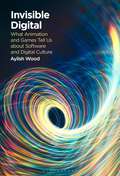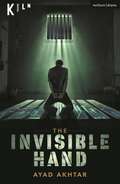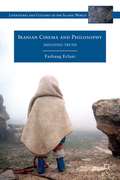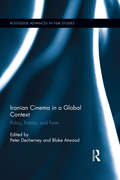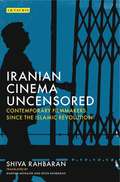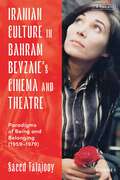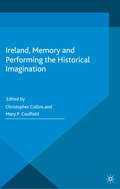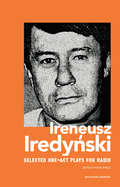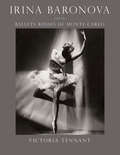- Table View
- List View
Invisible Connections: Dance, Choreography and Internet Communities (Innovations In Art And Design Ser.)
by Sita PopatThe first and only book to focus on dance on the Internet, Sita Popat‘s fascinating Invisible Connections examines how Internet and communication technologies offer dance and theatre new platforms for creating and performing work, and how opportunities for remote interaction and collaboration are available on a scale never before imaginable.Drawing
Invisible Digital: What Animation and Games Tell Us about Software and Digital Culture
by Aylish WoodInvisible Digital helps us makes sense of something we cannot see by presenting an innovative approach to digital images and digital culture. At its heart is a novel method for exploring software used in the creation of moving images as markers of converging cultural, organizational and technological influences. The three main case studies of Invisible Digital are the animated feature Moana (2016) and the computer games No Man's Sky (2016) and Everything (2017). All three were created using procedural techniques: simulation software for Moana, and procedural content generation for No Man's Sky and Everything. Production culture disclosures associated with procedural techniques often emphasize the influences of automated systems and their algorithms, making them ideal for a study that interrogates digital processes. The approach of Invisible Digital is informed by relational theories and the concept of entanglement based on materialist perspectives, combined with insights from work that more explicitly interrogates algorithms and algorithmic culture. Aylish Wood employs the notion of assemblages to introduce the concept of material-cultural narratives. Using this conceptual framework, she draws out material-cultural narratives for each case study to demonstrate what they reveal about software and digital culture. These analyses of software provide a widely applicable method through which moving image studies can contribute more fully to the wider and growing debates about algorithmic culture.
Invisible Digital: What Animation and Games Tell Us about Software and Digital Culture
by Aylish WoodInvisible Digital helps us makes sense of something we cannot see by presenting an innovative approach to digital images and digital culture. At its heart is a novel method for exploring software used in the creation of moving images as markers of converging cultural, organizational and technological influences. The three main case studies of Invisible Digital are the animated feature Moana (2016) and the computer games No Man's Sky (2016) and Everything (2017). All three were created using procedural techniques: simulation software for Moana, and procedural content generation for No Man's Sky and Everything. Production culture disclosures associated with procedural techniques often emphasize the influences of automated systems and their algorithms, making them ideal for a study that interrogates digital processes. The approach of Invisible Digital is informed by relational theories and the concept of entanglement based on materialist perspectives, combined with insights from work that more explicitly interrogates algorithms and algorithmic culture. Aylish Wood employs the notion of assemblages to introduce the concept of material-cultural narratives. Using this conceptual framework, she draws out material-cultural narratives for each case study to demonstrate what they reveal about software and digital culture. These analyses of software provide a widely applicable method through which moving image studies can contribute more fully to the wider and growing debates about algorithmic culture.
The Invisible Hand (Modern Plays)
by Ayad AkhtarYou see we are prisoners of a corrupt country that is our own making. But don't pretend you don't participate. You do. Of course you do.American banker Nick Bright knows that his freedom comes at a price. Confined to a cell in rural Pakistan, every second counts. Who will decide his fate? His captors, or the whims of the market?Ayad Akhtar is a Pulitzer Prize-winner, two-time Tony Award-nominee and winner of the Award in Literature from the American Academy of Arts and Letters.This newly revised edition of The Invisible Hand is published to coincide with the first major revival at London's Kiln Theatre in July 2021.
The Invisible Hand (Modern Plays)
by Ayad AkhtarYou see we are prisoners of a corrupt country that is our own making. But don't pretend you don't participate. You do. Of course you do.American banker Nick Bright knows that his freedom comes at a price. Confined to a cell in rural Pakistan, every second counts. Who will decide his fate? His captors, or the whims of the market?Ayad Akhtar is a Pulitzer Prize-winner, two-time Tony Award-nominee and winner of the Award in Literature from the American Academy of Arts and Letters.This newly revised edition of The Invisible Hand is published to coincide with the first major revival at London's Kiln Theatre in July 2021.
The Invisible Hand (Modern Plays)
by Ayad AkhtarYou see we are prisoners of a corrupt country that is our own making. But don't pretend you don't participate. You do. Of course you do. American banker Nick Bright knows that his freedom comes at a price. Confined to a cell in rural Pakistan, every second counts. Who will decide his fate? His captors, or the whims of the market? Ayad Akhtar is a Pulitzer Prize-winner, two-time Tony Award-nominee and winner of the Award in Literature from the American Academy of Arts and Letters. This newly revised edition of The Invisible Hand is published to coincide with the first major revival at London's Kiln Theatre in July 2021.
Invisible in a Bright Light
by Sally GardnerAn imaginative novel [with] a suspenseful challenge and a vivid backstage world of intrigue and romance... Original and rich' Sunday Times Book of the Week. From I, Coriander to Invisible in a Bright Light, Sally Gardner's first middle grade novel in 14 years soars with the imagination of a master story-teller. A pitch-perfect story about a crystal chandelier that splinters into a thousand pieces, a girl abandoned as a baby on the steps of an opera house and a dangerous game called the Reckoning. It is 1870: opening night at the Royal Opera House in a freezing city by the sea, where a huge, crystal chandelier in the shape of a galleon sparkles magically with the light of 750 candles. Celeste, a theatre rat, wakes up in a costume basket from what she hopes is a bad dream, to find that everyone at the theatre where she works thinks she is someone else. When the chandelier falls, she is haunted by a strange girl who claims to know Celeste's past and why she must risk playing a game called the Reckoning to try to save the people she loves. 'This is a classic Gardner modern fairy tale, full of fabulous locations and mesmerising characters. lt's a complicated, layered history tale... but do not underestimate this age group's intelligence and focus; young book lovers will be as delighted as they are challenged' Big Issue, Books of the Year 2019.
The Invisible Man: The Story of Rod Temperton, the 'Thriller' Songwriter
by Jed PitmanThe Invisible Man tells the remarkable story of how Rod Temperton worked his way up from a Grimsby fish factory to become one of the most successful songwriters of all time. Born in Cleethorpes in 1949, Temperton embarked on a career in music with the funk band Heatwave, for whom he wrote the international hits ‘Boogie Nights’ and ‘Always and Forever’, before his songwriting talent caught the attention of Michael Jackson’s legendary producer, Quincy Jones. For Jackson’s Off the Wall album, Temperton penned both the hit ‘Rock with You’ and the album’s title track. Three years later, continuing his relationship with the pair, Temperton started work on what would become the bestselling album of all time – Michael Jackson’s Thriller – writing three songs, including the now legendary title track. And yet despite collaborating with some of music’s biggest stars, including Donna Summer and Michael McDonald, Temperton was famously reclusive and seldom gave interviews, one of the exceptions being for author Jed Pitman’s Sony Award-winning radio documentary on Temperton allowed him unprecedented access to the great man.
Iranian Cinema: A Political History (International Library of Iranian Studies)
by Hamid Reza SadrRecent, post-revolutionary Iranian cinema has of course gained the attention of international audiences who have been struck by its powerful, poetic and often explicitly political explorations. Yet mainstream, pre-revolutionary Iranian cinema, with a history stretching back to the early twentieth century, has been perceived in the main as lacking in artistic merit and, crucially, as apolitical in content. This highly readable history of Iran as revealed through the full breadth of its cinema re-reads the films themselves to tell the full story of shifting political, economic and social situations. Reza Sadr argues that embedded within even the seemingly least noteworthy of mainstream Iranian films, we find themes and characterisations which reveal the political contexts of their time and which express the ideological underpinnings of a society. Beginning with the introduction of cinema to Iran through the Iranian monarchy the book covers the broad spectrum of Iran's cinema, offering vivid descriptions of all key films. Iranian Cinema looks at recurring themes and tropes, such as the rural versus the 'corrupt' city and, recently, the preponderance of images of childhood, and asks what these have revealed about Iranian society. The author brings the story up to date explaining Iranian filmmaking after the events of September 11, from Mohsen Makhmalbaf's astonishing Kandahar to Saddiq Barmak's angry work Osama, to explore this most recent and breathtaking revival in Iranian cinema.
Iranian Cinema and Philosophy: Shooting Truth (Literatures and Cultures of the Islamic World)
by Farhang ErfaniIn film studies, Iranian films are kept at a distance, as 'other,' different, and exotic. In reponse, this book takes these films as philosophically relevant and innovative. Each chapter of this book is devoted to analyzing a single film, and each chapter focuses on one philosopher and one particular aesthetic question.
Iranian Cinema in a Global Context: Policy, Politics, and Form (Routledge Advances in Film Studies)
by Peter Decherney Blake AtwoodIranian films have been the subject of much critical and scholarly attention over the past several decades, and Iranian filmmakers are mainstays of international film festivals. Yet most of the attention has been focused on a small segment of Iranian film production: auteurist art cinema. Iranian Cinema in a Global Context, on the other hand, takes account of the wide range of Iranian cinema, from popular youth films to low budget underground films. The volume also reassesses the global circulation of Iranian art cinema, looking at its reception at international festivals, in university curricula, and at the Academy Awards. A final theme of the volume explores the intersection between politics and film, with essays on post-Khatami reform influences, representations of ineffective drug policies, and the representation of Jewish characters in Iranian film. Taken together, the essays in this volume present a new definition of the field of Iranian film studies, one that engages global media flows, transmedia interaction, and a heterogeneous Iranian national cinema.
Iranian Cinema in a Global Context: Policy, Politics, and Form (Routledge Advances in Film Studies)
by Peter Decherney Blake AtwoodIranian films have been the subject of much critical and scholarly attention over the past several decades, and Iranian filmmakers are mainstays of international film festivals. Yet most of the attention has been focused on a small segment of Iranian film production: auteurist art cinema. Iranian Cinema in a Global Context, on the other hand, takes account of the wide range of Iranian cinema, from popular youth films to low budget underground films. The volume also reassesses the global circulation of Iranian art cinema, looking at its reception at international festivals, in university curricula, and at the Academy Awards. A final theme of the volume explores the intersection between politics and film, with essays on post-Khatami reform influences, representations of ineffective drug policies, and the representation of Jewish characters in Iranian film. Taken together, the essays in this volume present a new definition of the field of Iranian film studies, one that engages global media flows, transmedia interaction, and a heterogeneous Iranian national cinema.
Iranian Cinema Uncensored: Contemporary Film-makers since the Islamic Revolution (International Library of the Moving Image (PDF))
by Shiva RahbaranThe New Iranian Cinema is considered by many to be the most fascinating cultural phenomenon produced within the Islamic Republic of Iran. Containing twelve first-hand interviews with the most renowned film-makers living and working in contemporary Iran, this book provides insights into film-making within a society often at odds with its rulers. Reflecting upon the 1979 revolution and its influence on their work, as well as the effect of their films on Iranian audiences, film-makers such as Abbas Kiarostami and Jafar Panahi highlight the key issues surrounding the reception of Iranian cinema in the West and also its role in the development of Iran's global image. Through these conversations Shiva Rahbaran reveals that the seeds of the New Iranian Cinema were sown long before the revolution, and that Iranian film-makers gave rise to a cinema which became a global phenomenon despite censorship, sanctions and political isolation.
Iranian Culture in Bahram Beyzaie’s Cinema and Theatre: Paradigms of Being and Belonging (1959-1979)
by Saeed TalajooySince the beginning of his artistic career in 1959, Bahram Beyzaie's oeuvre has incorporated various aspects of Iranian, Euro-American, Chinese, Japanese, and Indian performance traditions and cinema. Beyzaie's work reformulates indigenous artistic and ritual forms and cultural narratives in plays and films whose emancipatory aesthetics have influenced several generations of writers, playwrights, and filmmakers. This book examines the origins and development of what the author identifies as Beyzaie's unique sense of creativity, using an interdisciplinary method of semiotic and cultural analysis to identify its manifestations in Beyzaie's films and plays of the 1960s and 1970s. It focusses on Beyzaie's early works, such as Downpour and Uncle Moustache, and how they engage with neglected aspects of Iranian culture to challenge mainstream approaches to writing and directing plays and films. In this way, the author argues, Beyzaie's work questions notions of being and belonging, by subverting exclusionist discourses on art, politics, society, culture, self and other, personal and collective identity, gender relations, intellectuals, heroes and villains, and children.
Iranian Culture in Bahram Beyzaie’s Cinema and Theatre: Paradigms of Being and Belonging (1959-1979)
by Saeed TalajooySince the beginning of his artistic career in 1959, Bahram Beyzaie's oeuvre has incorporated various aspects of Iranian, Euro-American, Chinese, Japanese, and Indian performance traditions and cinema. Beyzaie's work reformulates indigenous artistic and ritual forms and cultural narratives in plays and films whose emancipatory aesthetics have influenced several generations of writers, playwrights, and filmmakers. This book examines the origins and development of what the author identifies as Beyzaie's unique sense of creativity, using an interdisciplinary method of semiotic and cultural analysis to identify its manifestations in Beyzaie's films and plays of the 1960s and 1970s. It focusses on Beyzaie's early works, such as Downpour and Uncle Moustache, and how they engage with neglected aspects of Iranian culture to challenge mainstream approaches to writing and directing plays and films. In this way, the author argues, Beyzaie's work questions notions of being and belonging, by subverting exclusionist discourses on art, politics, society, culture, self and other, personal and collective identity, gender relations, intellectuals, heroes and villains, and children.
Iranian National Cinema: The Interaction of Policy, Genre, Funding and Reception (Iranian Studies)
by Anne Demy-GeroeThis book examines transformations in the production and domestic and international reception of Iranian cinema between 2000 and 2013 through the intersection of the political markers – the presidential terms of Reformist president Mohammad Khatami and his successor, the conservative Mahmoud Ahmadinejad – and filmic markers, particularly Jafar Panahi’s The Circle (2000) and Asghar Farhadi’s About Elly (2009). Through extensive field and media research, the book considers the interaction of a range of factors including government policy, Iranian national cinema genres and categories, intended audience, funding source, and domestic and international reception, to demonstrate the interplay between filmmakers and the government over these two successive presidencies. While the impact of politics on Iranian filmmaking has been widely examined, this work argues for a more nuanced understanding of politics in and of the Iranian cinema than has generally been previously acknowledged. Drawing on both personal experience as a juror at the Fajr International Film festival and interviews with significant filmmakers, producers, actors and other industry insiders, including senior bureaucrats and politicians, the volume is a key resource for anyone interested in politics and Iranian cinema.
Iranian National Cinema: The Interaction of Policy, Genre, Funding and Reception (Iranian Studies)
by Anne Demy-GeroeThis book examines transformations in the production and domestic and international reception of Iranian cinema between 2000 and 2013 through the intersection of the political markers – the presidential terms of Reformist president Mohammad Khatami and his successor, the conservative Mahmoud Ahmadinejad – and filmic markers, particularly Jafar Panahi’s The Circle (2000) and Asghar Farhadi’s About Elly (2009). Through extensive field and media research, the book considers the interaction of a range of factors including government policy, Iranian national cinema genres and categories, intended audience, funding source, and domestic and international reception, to demonstrate the interplay between filmmakers and the government over these two successive presidencies. While the impact of politics on Iranian filmmaking has been widely examined, this work argues for a more nuanced understanding of politics in and of the Iranian cinema than has generally been previously acknowledged. Drawing on both personal experience as a juror at the Fajr International Film festival and interviews with significant filmmakers, producers, actors and other industry insiders, including senior bureaucrats and politicians, the volume is a key resource for anyone interested in politics and Iranian cinema.
Ireland and Cinema: Culture and Contexts
by Barry MonahanThe volume offers a broad range of academic approaches to contemporary and historical Irish filmmaking and representations of nationality, national identity, and theoretical questions around the construction of Ireland and Irishness on the screen.
Ireland, Memory and Performing the Historical Imagination
by Mary P. CaulfieldThis book explores the performance of Irish collective memories and forgotten histories. It proposes an alternative and more comprehensive criterion of Irish theatre practices. These practices can be defined as the 'rejected', contested and undervalued plays and performativities that are integral to Ireland's political and cultural landscapes.
Ireland's Master Storyteller: The Collected Stories of Éamon Kelly
by Eamon KellyIn this collection, actor and seanchaí (traditional storyteller) Éamon Kelly's finest stories are collected for the first time: stories of the real Kerry and the magical past of the Gobán Saor, the heartbreak of emigration, the stations, the priests, the courting and dancing, the war between the sexes. Kelly mines a rich seam of humour and sadness out of resilience of a people rich in hospitality and generosity, imagination, culture and tradition.
Ireneusz Iredynski: Selected One-Act Plays for Radio
by Kevin WindleThis vibrant anthology of radio plays features works by one of Poland's 'angry young men' playwrights. Ireneusz Iredynski made his début in literature as a Polish 'angry young man' in the late 1950s. He moved with great versatility from verse to stage plays, film-scripts and plays for radio. While some of the plays in this collection seem to present a bleak view of life, they show a gentler side of Iredynski. Here it is people's dreams rather than their worst nightmares that are explored. In these plays, situations are kept simple and the theatrical technique is spare and economical, but yet, the playwright demonstrates an unfailing theatrical flair and shows himself a master of dramatic tension and the final unexpected twist.
Ireneusz Iredynski: Selected One-Act Plays for Radio
by Kevin WindleThis vibrant anthology of radio plays features works by one of Poland's 'angry young men' playwrights. Ireneusz Iredynski made his début in literature as a Polish 'angry young man' in the late 1950s. He moved with great versatility from verse to stage plays, film-scripts and plays for radio. While some of the plays in this collection seem to present a bleak view of life, they show a gentler side of Iredynski. Here it is people's dreams rather than their worst nightmares that are explored. In these plays, situations are kept simple and the theatrical technique is spare and economical, but yet, the playwright demonstrates an unfailing theatrical flair and shows himself a master of dramatic tension and the final unexpected twist.
Irina Baronova and the Ballets Russes de Monte Carlo
by Victoria TennantIn the 1930s and ’40s, the Ballets Russes de Monte Carlo toured the United States and the world, introducing many to ballet as an art form, while spreading the enduring image of the ballerina as an embodiment of feminine grace and sophistication. This sumptuous, illustrated history tells the story of the rise of modern ballet and its popularity through the life story of one of ballet’s most glamorous stars, Irina Baronova (1919–2008), prima ballerina for the Ballets Russes de Monte Carlo and later for Ballet Theatre in New York. Drawing on letters, correspondence, oral histories, and interviews, Baronova’s daughter, the actress Victoria Tennant, warmly recounts Baronova’s dramatic life, from her earliest aspirations to her grueling time on tour to her later years in Australia as a pioneer of the art. She begins with the Baronov family’s flight from Russia during the Revolution, which led them to Romania and later Paris, where at the age of thirteen, Baronova became a star, chosen by the legendary George Balanchine to join the Ballets Russes, where she danced the lead in Swan Lake. Tennant provides an intimate account of Baronova’s life as a dancer and rare behind-the-scenes stories of life on the road with the stars of the company. Spectacular photographs, a mix of archival images and family snapshots, offer many rare views of rehearsals, costumes, set designs, and the dancers themselves both at their most dazzling and in their most everyday. The story of Irina Baronova is also the story of the rise of ballet in America thanks to the Ballets Russes, who brought the magisterial beauty and star power of dance to big cities and small towns alike. Irina Baronova and the Ballet Russes de Monte Carlo offers a unique perspective on this history, sure to be treasured by dance patrons and aspiring stars.
Irina Baronova and the Ballets Russes de Monte Carlo
by Victoria TennantIn the 1930s and ’40s, the Ballets Russes de Monte Carlo toured the United States and the world, introducing many to ballet as an art form, while spreading the enduring image of the ballerina as an embodiment of feminine grace and sophistication. This sumptuous, illustrated history tells the story of the rise of modern ballet and its popularity through the life story of one of ballet’s most glamorous stars, Irina Baronova (1919–2008), prima ballerina for the Ballets Russes de Monte Carlo and later for Ballet Theatre in New York. Drawing on letters, correspondence, oral histories, and interviews, Baronova’s daughter, the actress Victoria Tennant, warmly recounts Baronova’s dramatic life, from her earliest aspirations to her grueling time on tour to her later years in Australia as a pioneer of the art. She begins with the Baronov family’s flight from Russia during the Revolution, which led them to Romania and later Paris, where at the age of thirteen, Baronova became a star, chosen by the legendary George Balanchine to join the Ballets Russes, where she danced the lead in Swan Lake. Tennant provides an intimate account of Baronova’s life as a dancer and rare behind-the-scenes stories of life on the road with the stars of the company. Spectacular photographs, a mix of archival images and family snapshots, offer many rare views of rehearsals, costumes, set designs, and the dancers themselves both at their most dazzling and in their most everyday. The story of Irina Baronova is also the story of the rise of ballet in America thanks to the Ballets Russes, who brought the magisterial beauty and star power of dance to big cities and small towns alike. Irina Baronova and the Ballet Russes de Monte Carlo offers a unique perspective on this history, sure to be treasured by dance patrons and aspiring stars.
Irish cinema in the twenty-first century
by Ruth BartonAn accessible, comprehensive overview of contemporary Irish cinema, this book is intended for use as a third-level textbook and is designed to appeal to academics in the areas of film studies and Irish studies. Responding to changes in the Irish production environment, it includes chapters on new Irish genres such as creative documentary, animation and horror. It discusses shifting representations of the countryside and the city, always with a strong concern for gender representations, and looks at how Irish historical events, from the Civil War to the Troubles, and the treatment of the traumatic narrative of clerical sexual abuse have been portrayed in recent films. It covers works by established auteurs such as Neil Jordan and Jim Sheridan, as well as new arrivals, including the Academy Award-winning Lenny Abrahamson.
